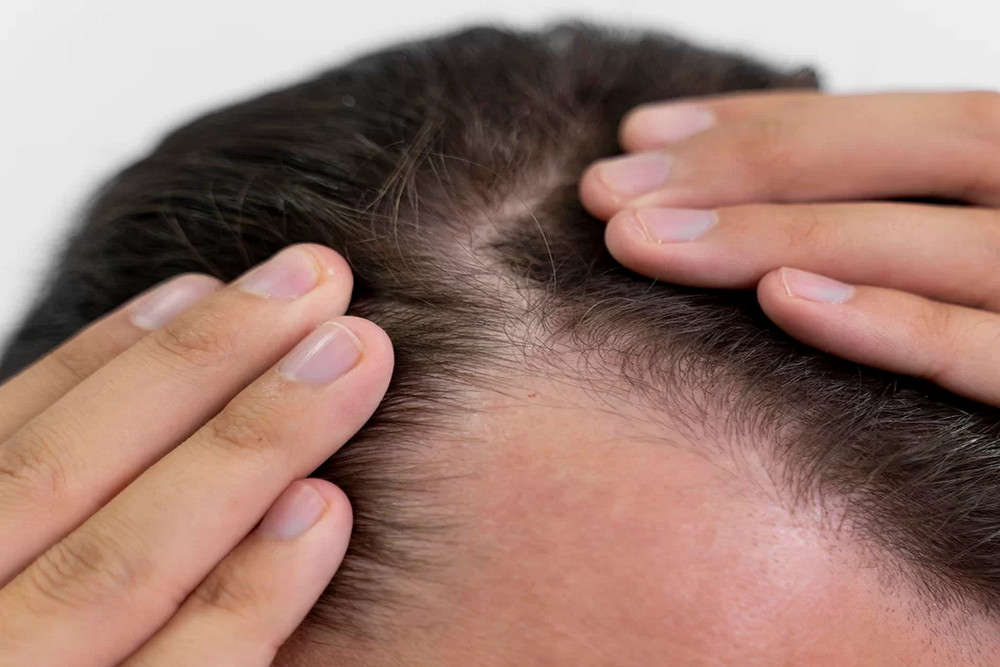Hair loss in men is common, due to a genetic condition present in at least half of the male population worldwide. It is part of a cycle by which hair fibers are regenerated, so it is common to lose between 25 and 60 hairs a day.
Hair loss manifests itself in different ways according to its origination cause, and can occur suddenly or progressively, in addition to affecting only the scalp or hair throughout the body.
Tabla de Contenidos
Among the most common symptoms of hair loss are:
- Gradual hair loss on the head. It is the most frequent hair loss type and usually occurs with aging. Usually in men, the forehead hairline begins to recede, which is known as frontal fibrous alopecia.
- Circular bald spots. It is an irregular hair loss pattern that occurs often in different scalp areas which can cause itching or pain prior to hair loss.
- Sudden hair loosening. Traumatic events can cause hair to loosen and fall out into locks when washing, combing, or brushing. This type of hair loss is associated with a temporary thinning of the hair.
- Hair loss all over the body. Hair loss throughout the body usually manifests with disorders and some medical treatments, the good news is that it usually grows back.
- Areas of desquamation. This is a ringworm symptom and is accompanied by brittle hair, inflammation and scalp redness.
When this situation worsens and there is a daily loss of more than 100 hairs, the cause is probably some type of hair alopecia.
Alopecia also known as Male Pattern Baldness is a condition that causes hair loss, affecting the scalp but, in some cases, also other parts of the body, such as the eyebrows. There are many types and causes of alopecia. The most common is androgenic, which affects men to a greater extent, but women are also affected, although it is common for them to hide it with haircuts, hairstyles, makeup, hats or wigs.
Although it is not the only cause of baldness, a diagnosis is often required to better understand what the cause may be in some cases.
The most common causes are:
- Androgenetic alopecia. A hereditary genetic factor that may occur around the age of 18 due to an increase in androgens (male hormones) in the body. Ironically, it is the same hormone that stimulates facial hair growth. Men with more facial hair are more susceptible to suffer from hair loss over the years.
- Alopecia areata. It is a condition in which hair is lost in certain areas of the head, leaving circular bald spots on the scalp about the size of a coin or bigger. It’s one of the easiest to identify due to its characteristic symptoms.
- Diffuse alopecia. It is a condition produced by different causes such as: diseases, infections, hypothyroidism, hormonal alterations, nutritional deficits, medications, after childbirth, among others. It is also known as telogen effluvium and causes hair loss in different parts of the head: eyebrows, eyelashes and hair.
- Scarring alopecia hair loss. It is produced by diseases, trauma or burns to the skin, with the danger that if the root is destroyed, the hair loss will be irreversible.
- Frontal fibrous alopecia hair loss. It is a gradual loss in the upper part of the head, which is related to aging and affects both men and women; in men the hairline of the forehead begins to recede backwards, while in women the line of the hair widens.
- Diseases. Chronic conditions such as diabetes and lupus can cause significant hair loss due to the medication used in their treatment.
- Poor nutrition. Malnutrition may cause damage to your body and hair; a diet lacking of B and C vitamins, as well as of minerals like zinc, iron and sulfur, may be the reason for hair loss.
- Stress and bad habits. Smoking and stress can negatively affect the hair growth cycle causing telogen effluvium, a sudden (but reversible) hair loss due to these and other causes, such as consuming certain types of medications and hormonal treatments, among others.
Hair loss can begin in different ways according to its origin. Sometimes it starts suddenly, affecting only the scalp, while other times it happens in different parts of the body, such as the beard and eyebrows, with itching or pain before it falls out.
Serious diseases and their treatment (such as cancer chemotherapies) can cause thinning and loss of hair throughout the body, although it grows back some time after stopping the drug.
These are just some of the most common reasons why you may be losing hair, so it is essential that you go to a specialist to determine the precise cause.
How quickly will I lose my hair?
Hair loss in men begins sometime in their twenties, but it usually takes between 15 and 25 years for this situation to lead to baldness. Half of fifty-year-old men have some baldness degree. However, some men go bald in less than five years. It is almost impossible to indicate how long the process will take, since this depends on the cause that originates it and the prevention type and treatment measures that are followed.
What are the risk factors?
There are some factors that increase the risk of hair loss, such as:
- Baldness Family history
- Significant weight loss
- Age
- Medical conditions such as diabetes and lupus
- Stress
- Malnutrition
How is the cause of hair loss diagnosed?
Knowing your medical history is key to determining the hair loss causes. Your doctor will ask you questions about your family history, diet, and hair care routine to determine the causes, and do a physical exam, and possibly prescribe some tests such as blood tests to identify diseases, a tensile test to determine the hair shedding volume, scalp biopsy to rule out infections, and an optical microscopy to identify hair shaft disorders.
Can hair loss be prevented?
In case of presenting any of these factors, it is recommended to adopt preventive measures, which is possible except in cases where baldness is caused by genetic reasons. With some types of hair loss, the following could work:
- Take care of the hair. Using products suitable for the hair type and avoiding pulling and brushing if the hair is wet reduces hair loss. The use of oils, perms, dyes and other strong treatments weaken the hair, damage it and can accelerate its fall. It is also recommended to avoid applying a lot of tension to your hair if you wear it with an elastic band or if you comb it in braids. Using UV protection is also a good measure to prevent its weakening.
- Check the side effects of medications. Some drugs and food supplements can cause hair loss, ask your doctor about their correct use. In the case of chemotherapy treatments, it is possible to use a cold cap to prevent hair loss during chemo, discuss all the possibilities with a specialist.
- Take care of your habits. Some studies have revealed that there is a relationship between smoking and baldness, so it is recommended to limit tobacco consumption to reduce hair loss.
At Hairfix we are experts in mens hair transplant, beard transplant, eyebrow transplant in Mexico and we will be able to diagnose your conditions to offer you an effective solution. Recovering your hair and feeling your best again is possible. Contact us today! We want you to experience the best hair transplant in Mexico fully informed every step of the way. Ask us about hair transplant price in Mexico.






